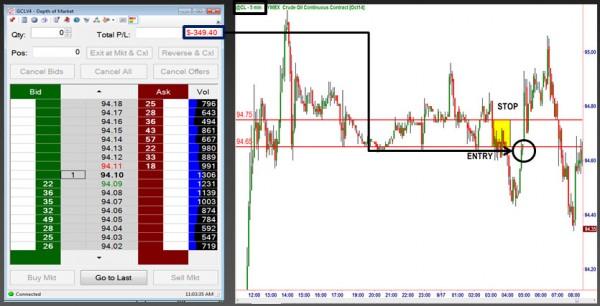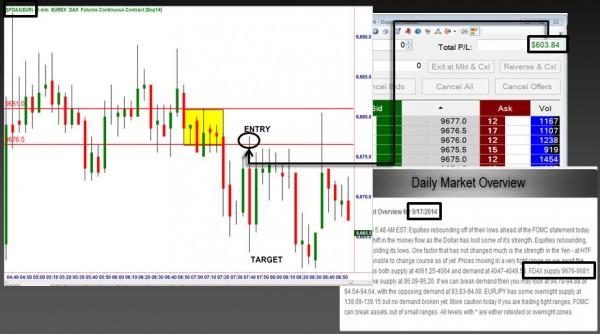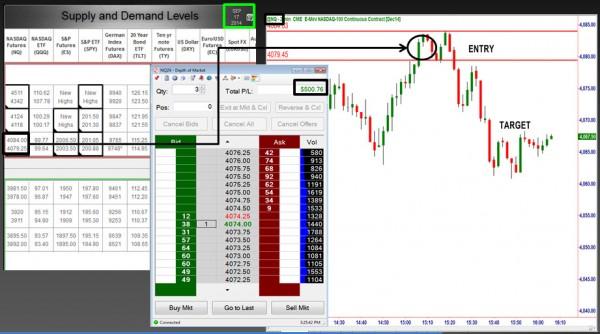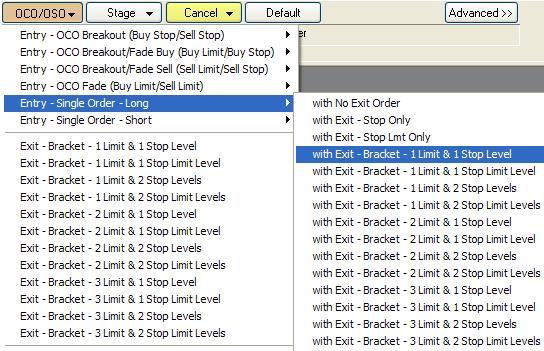![]()
From birth, we are conditioned to trade incorrectly. We naturally run from things we are fearful of and are drawn to things that make us feel good. If you take this action in trading, you are headed for trouble which in the trading world means losses. For example, if your invitation to buy into a market comes only after an uptrend is well underway, all the indicators are pointed up, and the news is good on that market, where do you think price is in that market? Yep, it’s likely very high. To buy here completely goes against how you make money buying and selling anything and is very high risk. Never forget, when you buy, many people have to buy after you and at higher prices or there is no chance you will profit in your trade. To obtain an entry that allows you to buy before others and at price levels where the risk is low, most of the time (if not all the time) you are buying at the end of a downtrend, when most indicators are pointing down, and when the news is bad. This action is completely against our mental make – up. As I said before, we are conditioned from birth to trade and invest incorrectly. That action or belief system is often reinforced during the many years of traditional finance/economics high school and college education. For example, most college courses on markets teach to us to do plenty of research on a stock before buying into that market. The general rule is to make sure the company has good earnings, good management, is a leader in its industry, and has a stock price that is in an uptrend. Again I ask you, where do you think the price of the stock is when all this criteria is true? Almost always, the stock price is very high when this criteria is true which ensures that if you buy now, you are simply helping everyone else who bought before you.
In my opinion, there are two things that you must have if you are to succeed at trading for a career. First, you must have a solid understanding of how the market really works and a rule based strategy based on the objective laws of supply and demand. Due to very little regulation in the trading/investing education industry, most people learn to trade completely wrong from someone who is good at marketing but not so good at trading. This ensures that perhaps as much as 80% of people who attempt to trade will fail as they never learn how a market really works and instead, are poisoned with trading education and information that has them buying high and selling low. This path is fraught with lagging indicators and oscillators and conventional technical analysis information that leads to high risk, low reward trading and investing. Second, you must have the discipline to follow your rule based strategy. So, of the roughly 20% of hopeful traders who actually obtain proper trading education, the lack of discipline factor likely eliminates 80% of them which adds up to a select few that ever make it. Before you stop reading this piece and throw it into your fireplace because it is so negative, sit tight and read on, help is on the way…
I have been trading Stocks, Futures, Forex, and Options for many years and being around new traders at Online Trading Academy, I see so many people come into the program not having the two most important pieces of the trading puzzle mentioned above. Let’s go over some very recent trades from our program in hopes that you will get closer to having a solid understanding of how a market works and then I will show you how we handle the discipline issues that can be so challenging for new traders in the XLT.
Income Trade – Crude Oil futures: September 17, 2014 – Loss: $349.40
Here are three typical income trades in Crude Oil, the DAX, and the NASDAQ markets. Two of the trades were profitable and one was a loss, all on the same day last week. Early in the morning, I simply marked off the demand and supply levels as that is where banks are most likely buying and selling and I want to buy or sell there as well. Once the market gets going, I was very happy to buy from someone who wanted to sell after a decline in price and at predetermined demand (wholesale) prices as that is the low risk / high reward / high probability time to buy. Understand that the laws of supply and demand ensure that the seller who sells after a decline in price and at price levels where demand exceeds supply will most often lose so we use our rule based strategy to make sure we are there to take the other side of that trade and buy from the ill-informed seller. Next, when price rallies to our pre-determined supply level (retail prices), I want to sell short but the key question for your understanding is this, who am I selling to? We are selling to the trader who is making the same two mistakes every consistent losing buyer and seller of anything makes. First they are buying after a big rally in price, mistake number one. Second, they are buying at a price level where the chart is suggesting, supply exceeds demand. Why would someone buy at that price level? They would buy because they are conditioned to buy when the news is good, a solid uptrend is underway, and simply because the basic human brain is wired to buy when everyone else is buying (Sheep).
Income Trade – DAX: September 17, 2014 – Profit: $603.84
Below is a chart of the NASDAQ futures. I first identified the supply level, put my lines on the chart, and then planned the trade. Notice how price arrived to the level. The rally that preceded my entry was a healthy and obvious uptrend. Price rallies with big green candles, likely associated with good news, and advancing indicators. Most traders and investors are invited to buy when price rallies, especially as it did with the NASDAQ trade below. These realities of rising prices can make it very scary for the new trader to push the sell button where I did at supply.
Income Trade – NASDAQ futures: September 17, 2014 – Profit: $500.76
The Answer
If you think I or members of the Mastermind Community are able to take these trades because we have somehow de-humanized our brains and have some super powers that only successful traders have, think again. We think and feel much of the same things everyone else thinks and feels. The key is that I realized years ago that my human brain is flawed when it comes to proper trading and has the potential to be my own worst enemy so I make sure I do my objective rule based analysis based on the laws of supply and demand and then take full advantage of today’s fantastic order execution capabilities to make sure emotion never even has a chance to come into my trading world. Below, I have taken a picture of what type of order I would use. By selecting the “OCO” (order cancels order) order below, I am able to enter an order to buy at demand, enter a protective sell stop order to limit the risk because you (and I) will have losses from time to time like my trade above, and also enter a sell limit order to take profits, all at the same time. Once I set up that order and execute it, I am hands off for that entire trade from start to completion. This accomplishes two things for you and I. First, it takes care of the emotions and second, it means we don’t have to sit in front of the computer screen all day; life is way too short to do that anymore! I call this “set it and forget it” trading.
The Answer
Today, just about any type of order you can think of is available. I encourage you to begin to take advantage of the opportunity to set and forget your income and wealth opportunities. There are too many types of orders and features to share in this article so email us if you have questions.
As always, never forget that those who know what they are doing in the markets simply get paid from those who don’t so make sure you have the two issues discussed in this piece figured out before you put your hard earned money at risk.
Hope this was helpful, have a great day.
Note: All information on this page is subject to change. The use of this website constitutes acceptance of our user agreement. Please read our privacy policy and legal disclaimer. Opinions expressed at FXstreet.com are those of the individual authors and do not necessarily represent the opinion of FXstreet.com or its management. Risk Disclosure: Trading foreign exchange on margin carries a high level of risk, and may not be suitable for all investors. The high degree of leverage can work against you as well as for you. Before deciding to invest in foreign exchange you should carefully consider your investment objectives, level of experience, and risk appetite. The possibility exists that you could sustain a loss of some or all of your initial investment and therefore you should not invest money that you cannot afford to lose. You should be aware of all the risks associated with foreign exchange trading, and seek advice from an independent financial advisor if you have any doubts.
Editors’ Picks
EUR/USD clings to daily gains above 1.0650

EUR/USD gained traction and turned positive on the day above 1.0650. The improvement seen in risk mood following the earlier flight to safety weighs on the US Dollar ahead of the weekend and helps the pair push higher.
GBP/USD recovers toward 1.2450 after UK Retail Sales data

GBP/USD reversed its direction and advanced to the 1.2450 area after touching a fresh multi-month low below 1.2400 in the Asian session. The positive shift seen in risk mood on easing fears over a deepening Iran-Israel conflict supports the pair.
Gold holds steady at around $2,380 following earlier spike

Gold stabilized near $2,380 after spiking above $2,400 with the immediate reaction to reports of Israel striking Iran. Meanwhile, the pullback seen in the US Treasury bond yields helps XAU/USD hold its ground.
Bitcoin Weekly Forecast: BTC post-halving rally could be partially priced in Premium

Bitcoin price shows no signs of directional bias while it holds above $60,000. The fourth BTC halving is partially priced in, according to Deutsche Bank’s research.
Week ahead – US GDP and BoJ decision on top of next week’s agenda

US GDP, core PCE and PMIs the next tests for the Dollar. Investors await BoJ for guidance about next rate hike. EU and UK PMIs, as well as Australian CPIs also on tap.
RECOMMENDED LESSONS
Making money in forex is easy if you know how the bankers trade!
Discover how to make money in forex is easy if you know how the bankers trade!
5 Forex News Events You Need To Know
In the fast moving world of currency markets, it is extremely important for new traders to know the list of important forex news...
Top 10 Chart Patterns Every Trader Should Know
Chart patterns are one of the most effective trading tools for a trader. They are pure price-action, and form on the basis of underlying buying and...
7 Ways to Avoid Forex Scams
The forex industry is recently seeing more and more scams. Here are 7 ways to avoid losing your money in such scams: Forex scams are becoming frequent. Michael Greenberg reports on luxurious expenses, including a submarine bought from the money taken from forex traders. Here’s another report of a forex fraud. So, how can we avoid falling in such forex scams?
What Are the 10 Fatal Mistakes Traders Make
Trading is exciting. Trading is hard. Trading is extremely hard. Some say that it takes more than 10,000 hours to master. Others believe that trading is the way to quick riches. They might be both wrong. What is important to know that no matter how experienced you are, mistakes will be part of the trading process.




